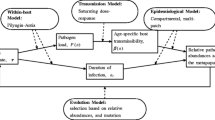Abstract
We examined the propagation of an infectious disease and the eventual extinction of the host population in a lattice-structured population. Both the host colonization and pathogen transmission processes are assumed to be restricted to act between the nearest neighbor sites. The model is analyzed by an improved version of pair approximation (IPA). Pair approximation is a technique to trace the dynamics of the number of nearest neighbor pairs having particular states, and IPA takes account of the clustering property of lattice models more precisely. The results are checked by computer simulations. The analysis shows: (i) in a one-dimensional lattice population, a pathogen cannot invade a host population no matter how large is the transmission rate; (ii) in a two-dimensional lattice population, pathogens will drive the host to extinction if the transmission rate is larger than a threshold. These results indicate that spatially structured population models may give qualitatively different results from conventional population models, such as Lotka-Volterra ones, without spatial structure.
Similar content being viewed by others
References
Brower, R. C., Furman, M. A., Moshe, M.: Critical exponents for the Reggeon quantum spin model. Phys. Lett. 76B, 213–219 (1978)
Comins, H. N., Blatt, D. W. E.: Prey-predator models in spatially heterogeneous environments. J. Theor. Biol. 48, 75–83 (1974)
De Roos, A. M., McCauley, E., Wilson, W. G.: Mobility versus density-limited predator-prey dynamics on different spatial scales. Proc. R. Soc. Lond., Ser. B 246, 117–122 (1991)
Dickman, R.: Kinetic phase transitions in a surface-reaction model: mean-field theory. Phys. Rev. A 34, 4246–4250, (1986)
Durrett, R.: Lecture notes on particle systems and percolation. California: Wadsworth & Brooks/Cole 1988
Durrett, R., Neuhauser, C.: Epidemics with recovery in D=2. Ann. Appl. Probab. 1, 189–206 (1991)
Durrett, R., Swindle, G.: Are there bushes in a forest? Stoch. Proc. Appl. 37, 19–31 (1991)
Grassberger, P., De La Torre, A.: Reggeon field theory (Schlögl's first model) on a lattice: Monte Carlo calculations of critical behaviour. Ann. Phys. 122, 373–396 (1979)
Green, D. G.: Simulated effects of fire, dispersal and spatial pattern on competition within forest mosaics. Vegetatio 82, 139–153 (1989)
Hamilton, W. D.: Sex versus non-sex versus parasite. Oikos 35, 282–290 (1980)
Hamilton, W. D., Axelrod, R., Tanase, R.: Sexual reproduction as an adaptation to resist parasites. Proc. Natl. Acad. Sci. USA 87, 3566–3573 (1990)
Harris, T. E.: Contact interactions on a lattice. Ann. Probab. 2, 969–988 (1974)
Hassell, M. P., Comins, H. N., May, R. M.: Spatial structure and chaos in insect population dynamics. Nature 353, 255–258 (1991)
Iwasa, Y., Satō, K., Nakashima, S.: Dynamic modeling of wave regeneration (Shimagare) in subalpine Abies forests. J. Theor. Biol. 152, 143–158 (1991)
Iwasa, Y., Satō, K., Kakita, M., Kubo, T.: Modelling biodiversity: Latitudinal gradient of forest species diversity. In: Schulze, E.-D., Mooney, H. (eds.) Biodiversity and ecosystem function. Berlin Heidelberg New York: Springer 1993
Katori, M., Konno, N.: Correlation inequalities and lower bounds for the critical value γ c of contact processes. J. Phys. Soc. Jpn. 59, 877–887 (1990)
Katori, M., Konno, N.: Upper bounds for survival probability of the contact process. J. Stat. Phys. 63, 115–130 (1991)
Kawano, K., Iwasa, Y.: A lattice structured model for beech forest dynamics: the effect of understory dwarf bamboo. Ecol. Modelling 66, 261–275 (1993)
Konno, N., Katori, M.: Applications of the CAM based on a new decoupling procedure of correlation functions in the one-dimensional contact process. J. Phys. Soc. Jpn. 59, 1581–1592 (1990)
Liggett, T. M.: Interacting particle systems. Berlin Heidelberg New York: Springer 1985
Ludwig, D., Aronson, D. G., Weinberger, H. F.: Spatial patterning of the spruce budworm. J. Math. Biol. 8, 217–258 (1979)
Matsuda, H.: Conditions for the evolution of altruism. In: Itô, Y., Brown, J. L., Kikkawa, J. (eds.) Animal societies: Theories and facts, pp. 67–80. Tokyo: Japan Sci. Soc. Press 1987
Matsuda, H., Tamachi, N., Sasaki, A., Ogita, N.: A lattice model for population biology. In: Teramoto, E., Yamaguti, M. (eds.) Mathematical topics in population biology, morphogenesis, and neurosciences. (Lect. Notes Biomath., Vol. 71, pp. 154–161) Berlin Heidelberg New York: Springer 1985
Matsuda, H., Ogita, N., Sasaki, A., Satō, K.: Statistical mechanics of population: The lattice Lotka-Volterra model. Prog. Theor. Phys. 88, 1035–1049 (1992)
May, R. M., Anderson, R. M.: Population biology of infectious diseases: Part II. Nature 280, 455–461 (1979)
May, R. M., Anderson, R. M.: Epidemiology and genetics in the coevolution of parasites and hosts. Proc. R. Soc. Lond., Ser. B 219, 281–313 (1983)
May, R. M., Anderson, R. M.: Transmission dynamics of HIV infection. Nature 326, 137–142 (1987)
Mollison, D.: Spatial contact models for ecological and epidemic spread. J. R. Statist. Soc., Ser. B 39, 283–326 (1977)
Mollison, D., Kuulasmaa, K.: Spatial epidemic models: theory and simulations. In: Bacon, P. J. (ed.) Population dynamics of rabies in wildlife, pp. 291–309. London: Academic Press 1985
Nowak, M. A., May, R. M.: Evolutionary games and spatial chaos. Nature 359, 826–829 (1992)
Ootsuki, T., Keyes, T.: Kinetic growth percolation: Epidemic processes with immunization. Phys. Rev. A 33, 1223–1232 (1986)
Satō, K., Iwasa, Y.: Modeling of wave regeneration (Shimagare) in subalpine Abies forests: Population dynamics with spatial structure. Ecology 74, 1538–1550 (1993)
Tainaka, K.: Lattice model for the Lotka-Volterra system. J. Phys. Soc. Jpn. 57, 2588–2590 (1988)
Yachi, S., Kawasaki, K., Shigesada, N. Teramoto, E.: Spatial patterns of propagating waves of fox rabies. Forma 4, 3–12 (1989)
Author information
Authors and Affiliations
Rights and permissions
About this article
Cite this article
Satō, K., Matsuda, H. & Sasaki, A. Pathogen invasion and host extinction in lattice structured populations. J. Math. Biol. 32, 251–268 (1994). https://doi.org/10.1007/BF00163881
Received:
Revised:
Issue Date:
DOI: https://doi.org/10.1007/BF00163881




